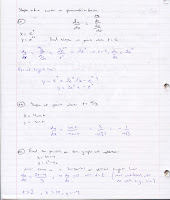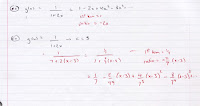The main topic for today was finding the length of a curve (given either with parametric equations or as y as a function of x). The fundamental idea is pretty easy (Pythagorean Theorem!) with some algebra tricks thrown in to make the formula an integral.
Unfortunately, while it's a pretty cool topic - most of the integrals generated are ridiculously tough to evaluate. Almost always, you have a square root and it involves something more complicated than a linear function. So for these types of problems, expect to have to just set up the integral (or be allowed to use the calculator to find a numerical answer).
Notes from class are below.
Thursday, February 16, 2012
Tuesday, February 14, 2012
Feb 14 - Parametric Equations (Slope)
Today we talked about finding the slope of a curve defined by parametric equations. The formula for dy/dx in parametric is a consequence of the Chain Rule and should feel fairly intuitive:
dy/dx = (dy/dt) / (dx/dt)
We worked a couple examples, revisiting the basic derivative questions of finding the slope, writing the equation of a tangent line or determining where a graph might have horizontal or vertical tangent lines. Notice that while it is comfortable having an idea of what the graph looks like, it's not generally necessary to our work.
Notes are posted below.
dy/dx = (dy/dt) / (dx/dt)
We worked a couple examples, revisiting the basic derivative questions of finding the slope, writing the equation of a tangent line or determining where a graph might have horizontal or vertical tangent lines. Notice that while it is comfortable having an idea of what the graph looks like, it's not generally necessary to our work.
Notes are posted below.
Monday, February 13, 2012
Feb 13 - Parametric Equations
We worked a couple problems from the worksheet prior to the quiz. I'll reiterate that ultimately, you will only be responsible for having the Taylor series for e^x, cos x, and sin x memorized. No others need to be memorized.
I spent most of class today _playing_ mathematics. I hope students who were in class got a good feel for how weird and abstract and cool pure mathematics can be and how new and different ways to represent concepts can provide deeper understanding. Unfortunately, I didn't have any real notes for class prepared so I don't have anything to scan in tonight. But I'll update it tomorrow.
We are starting parametric equations (with calculus) tomorrow. There is a short assignment tonight - just using your calculator to generate some graphs.
I spent most of class today _playing_ mathematics. I hope students who were in class got a good feel for how weird and abstract and cool pure mathematics can be and how new and different ways to represent concepts can provide deeper understanding. Unfortunately, I didn't have any real notes for class prepared so I don't have anything to scan in tonight. But I'll update it tomorrow.
We are starting parametric equations (with calculus) tomorrow. There is a short assignment tonight - just using your calculator to generate some graphs.
Wednesday, February 8, 2012
Feb 8 - Taylor Series (Geometric Series)
Today was our second day of finding Taylor series for functions. We
focused on special rational functions that we could treat as
representing the sum of a geometric series. The sum formula we're
building on from last year in Pre-Calculus is:
Sum of infinite geometric series = 1st term / (1 - ratio),
with the condition that the | ratio | < 1.
We worked a couple examples - mostly this is just some arithmetic and algebra.
Notes from today are below.
Sum of infinite geometric series = 1st term / (1 - ratio),
with the condition that the | ratio | < 1.
We worked a couple examples - mostly this is just some arithmetic and algebra.
Notes from today are below.
Tuesday, February 7, 2012
Feb 7 - Taylor Series
Today was an introduction to the idea of a Taylor Series. The general
idea of a Taylor Series is that we are going to take functions and
represent them as "infinite" polynomials. The "Why?" question will be
answered eventually but for now we're going to focus on the "How?"
question.
Most of the Taylor Series we will work with will have the form:
a0 + a1*x + a2*x^2 + a3*x^3 + ... + an*x^n + ...
where each of the coefficients has the form an = f^n(0) / n! (where f^n(0) means "the nth derivative of f(x) evaluated at x = 0).
Generally, a Taylor Series has the form:
a0 + a1*(x - c) + a2*(x - c)^2 + a3*(x - c)^3 + ... + an*(x - c)^n + ...
where each of the coefficients has the form an = f^n(c) / n!
You will eventually be responsible for the Taylor series for e^x, sin x and cos x.
Here is the animation I used in class to illustrate the Taylor series for sin x.
Notes from today are below.
Most of the Taylor Series we will work with will have the form:
a0 + a1*x + a2*x^2 + a3*x^3 + ... + an*x^n + ...
where each of the coefficients has the form an = f^n(0) / n! (where f^n(0) means "the nth derivative of f(x) evaluated at x = 0).
Generally, a Taylor Series has the form:
a0 + a1*(x - c) + a2*(x - c)^2 + a3*(x - c)^3 + ... + an*(x - c)^n + ...
where each of the coefficients has the form an = f^n(c) / n!
You will eventually be responsible for the Taylor series for e^x, sin x and cos x.
Here is the animation I used in class to illustrate the Taylor series for sin x.
Notes from today are below.
 | |
| p1 |
 | |
| p2 |
Feb 6 - Integration
The main goal today was to get practice evaluating integrals. With all the techniques we now have to use, finding antiderivatives can become a very tough exercise and recognizing which technique to use when will take time and patience.
We worked several examples in class. The assignment for tomorrow will be one of the most challenging of the semester. :0
Notes from today are below.
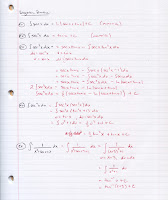
We worked several examples in class. The assignment for tomorrow will be one of the most challenging of the semester. :0
Notes from today are below.

Friday, February 3, 2012
Feb 3 - Integration by Partial Fractions
So this is a very algebra-intensive concept. It's a technique for finding antiderivatives of rational functions. Generally, you want to try our other techniques before resorting to partial fractions.
Conceivably, the polynomial in the denominator might have a quadratic factor (x^3 - 8 factoring into (x - 2)(x^2 + 2x + 4)) or a repeated factor (x^3 - 2x^2 + x factoring into x(x - 1)^2). In these instances, the algebra of solving the partial fractions is a bit more challenging but as it turns out, we will not have to worry about those cases in BC Calculus. Simple, non-repeated linear terms are the only partial fractions problems we'll see according to the BC curriculum from The College Board.
(If we had "extra" days for instruction - this is the kind of thing I might spend another day on...)
We worked a couple examples in class. One thing to remember is that partial fractions only works if the denominator of the rational function is greater than that of the numerator. If the degrees are the same (or the top is greater), then there is division to be done.
Notes are below.
p1
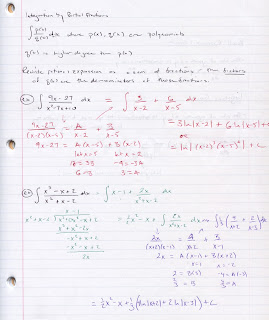
p2
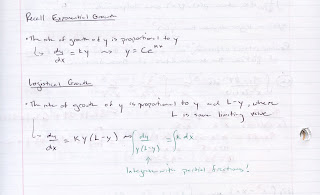
Conceivably, the polynomial in the denominator might have a quadratic factor (x^3 - 8 factoring into (x - 2)(x^2 + 2x + 4)) or a repeated factor (x^3 - 2x^2 + x factoring into x(x - 1)^2). In these instances, the algebra of solving the partial fractions is a bit more challenging but as it turns out, we will not have to worry about those cases in BC Calculus. Simple, non-repeated linear terms are the only partial fractions problems we'll see according to the BC curriculum from The College Board.
(If we had "extra" days for instruction - this is the kind of thing I might spend another day on...)
We worked a couple examples in class. One thing to remember is that partial fractions only works if the denominator of the rational function is greater than that of the numerator. If the degrees are the same (or the top is greater), then there is division to be done.
Notes are below.
p1

p2

Thursday, February 2, 2012
Feb 2 - Integration by Parts
Yesterday most of classtime was dedicated to working on a volume worksheet - taking the same region, R, and creating a variety of solids.
Today, we learned the first of two new integration techniques for the week. It is called integration by parts and has the basic rule:
Integral of u*dv = u*v - Integral of v*du
It is based on the formula used for the product of functions (the Product Rule).
My thought process is that once I've decided that an integral can't be done by substitution, I'll try integration by parts. The first step for me is to determine "dv." Essentially, dv should be the "most complicated" part of the integral that I can integrate easily. "u" is whatever is leftover.
We worked several examples in class. Notes from class are below.
p1
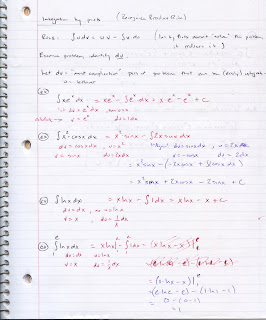
p2
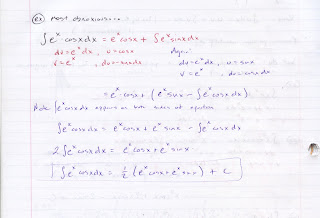
Today, we learned the first of two new integration techniques for the week. It is called integration by parts and has the basic rule:
Integral of u*dv = u*v - Integral of v*du
It is based on the formula used for the product of functions (the Product Rule).
My thought process is that once I've decided that an integral can't be done by substitution, I'll try integration by parts. The first step for me is to determine "dv." Essentially, dv should be the "most complicated" part of the integral that I can integrate easily. "u" is whatever is leftover.
We worked several examples in class. Notes from class are below.
p1

p2

Subscribe to:
Comments (Atom)


